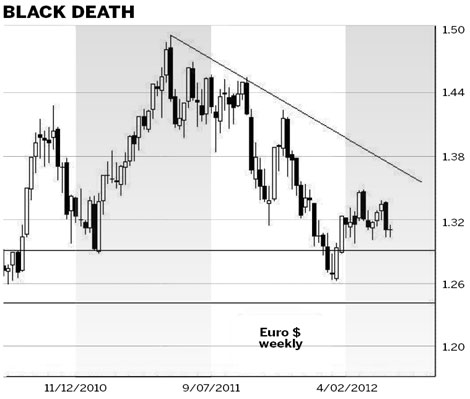Containing the contagion across Europe
Updated: 2012-04-16 07:55
By Daryl Guppy (China Daily)
|
|||||||||||
A contagion is a disease that spreads, infecting otherwise healthy bodies. We think of contagions such as the bubonic Black Death plague that spread rapidly throughout medieval Europe. The current financial contagion in Europe is moving much more slowly but it is inflicting as much damage as the Black Death. It is a crisis slowly creeping across Europe. Our focus tends to be on one country at a time, and we ignore other countries that are also ailing. Weak economies succumb more quickly to this financial contagion. Stronger countries, such as Germany and France are not immune.
 |
Greece was the original focus of concern, with Italy and then Spain also appearing on the contaminated list. The progress in Greece is a template for the effects of this contagion in other European countries. Like the Black Death, the results are inevitable, although the exact details may different in form but not in substance.
The Athens Stock Index (ASE) fell more than 50 percent in the last year from 1531 in April last year to a low of 645 in January. These falls followed the fall from 2200 in January in 2010 to 1531 in April in 2011. Falls of similar magnitudes are possible on the stock exchanges of countries including Spain and Italy.
The health of the European economy is tracked to some degree with the behavior of the eurodollar exchange rate. The tracking is imperfect because the strength or weakness of the US dollar also has an effect on the behavior of the eurodollar exchange rate. One side of the currency pair - the euro - is suffering from the European contagion. The other side of the currency pair - the US dollar - is recovering from its own brush with economic weakness and financial collapse. However, the eurodollar exchange rate remains an effective way of monitoring the impact of this creeping European contagion crisis.
The eurodollar weekly chart is dominated by a strong and well established downward trend that has been in place since May 2011 from a high of $1.49. This downward trend line was tested in September last year with a high near $1.45 followed by a retreat. The current rally highs to near $1.34 have reacted away from the trend line area. This behavior suggests continuing weakness in the euro. There is no evidence that the euro can strengthen and move above the established downward trend line. The downward trend line points to continued weakness in the eurodollar exchange rate
How low can the euro go? The answer to this question is provided by the historical support levels. In a falling trend these levels act as a support, providing a base for a rebound. Once the support level fails, then the level becomes a resistance level and acts to inhibit any future rally.
The first key support level is near $1.29. The market has recently developed minor support near $1.30 but it is the $1.29 level that is historically important.
A fall below $1.20 has the next support level near $1.24. This defined the limits of euro weakness in 2008 and 2009 so there is a high probability it will again provide good support. However in 2010 the euro dipped to a low of $1.19 which was near to the 2005 lows. A fall below support near $1.24 has the next support target near $1.19. The last 10 years have seen the euro trading above $1.19 but in 2001 it was trading at $0.88. Falls below $1.24 are not unprecedented. The slow, creeping European contagion has the potential to drag the euro much lower. Investors are looking for solid support above $1.24 and will use this as proof that the European contagion can be contained.
The author is a well-known international financial technical analysis expert.

Today's Top News
President Xi confident in recovery from quake
H7N9 update: 104 cases, 21 deaths
Telecom workers restore links
Coal mine blast kills 18 in Jilin
Intl scholarship puts China on the map
More bird flu patients discharged
Gold loses sheen, but still a safe bet
US 'turns blind eye to human rights'
Hot Topics
Lunar probe , China growth forecasts, Emission rules get tougher, China seen through 'colored lens', International board,
Editor's Picks

|

|

|

|

|

|





